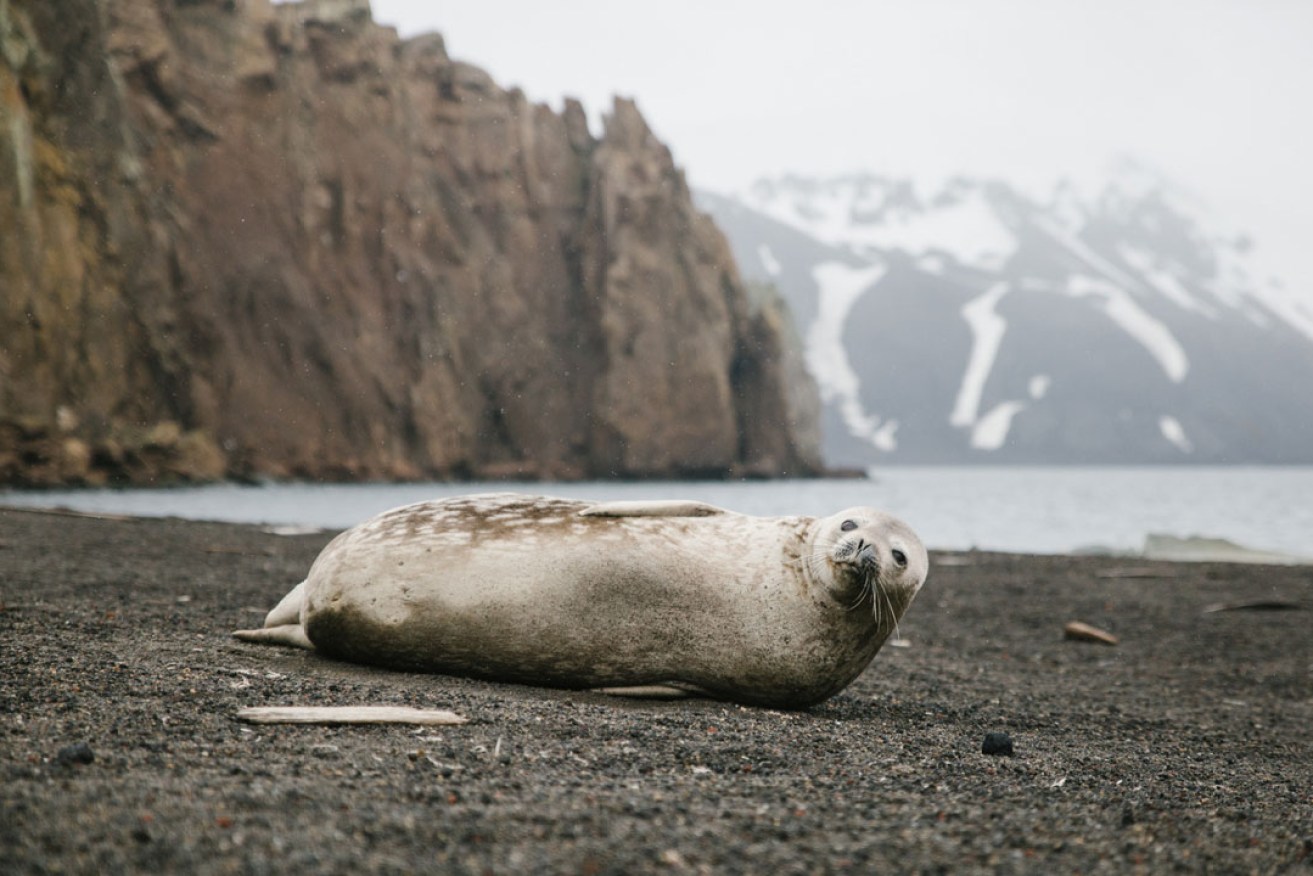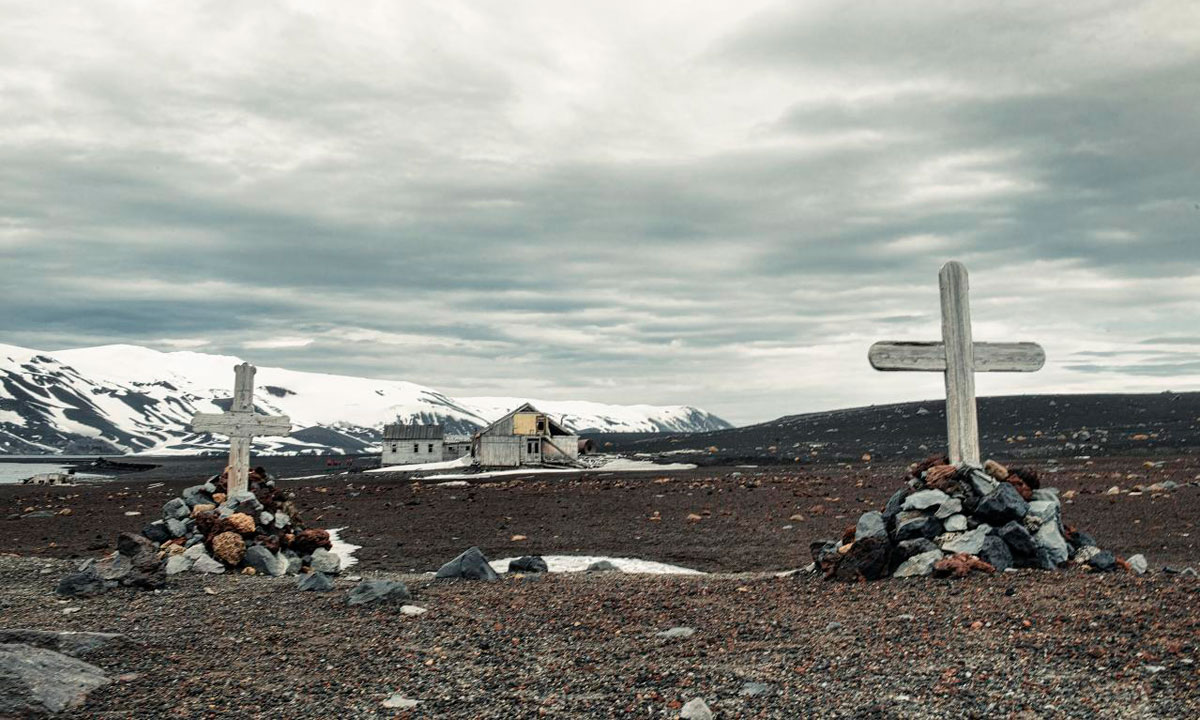Joy among ghosts at Deception Island
Deception Island in the South Shetland Islands offers grim reminders of a time when whales were hunted and killed in their thousands. It is a place full of deception – morbid and unpredictable, but also heavenly.

A seal reclaims the volcanic rock beach of Deception Island. Photo: John Bozinov / AAP
Abandoned homes, full of ghosts, are the most fascinating kind of museum. An iron stove without its doors, a battered sewing machine at a broken table, a dirty hessian rug blowing out of an open window – they all offer titillating details of lives lived here.
I try to picture the last time someone stood up and walked out of this place, all those decades ago.
It’s hard to imagine, because given the 50-knot winds and blinding Antarctic blizzard whipping my face, it’s hard to imagine anyone living here at all.
These wooden huts on Deception Island, in the South Shetland Islands, look dishevelled now. When they housed Norwegian whalers during the early 20th century, they probably weren’t much better.
On approach, Deception looks like any other any other island, but when you pass through the rocky channel of Neptune’s Bellows, you discover it’s actually in the shape of a horseshoe with a large, flooded caldera in its centre.
This is its first deception, which gave the island its name when American sealer Nathaniel Palmer sailed by in 1820.
In our little nook of Whalers Bay, barren volcanic slopes and ash-layered glaciers slide into a rocky, black beach littered with the industrial flotsam of whale oil extraction. Boats and barrels are scattered among the whalebones.
The huge tank that boiled the whales’ bodies still looms high on the beach, rusty and sombre – a grim beacon to a time when these majestic mammals were hunted and killed in their thousands.
Gnarly, leftover whale carcasses would have clogged the bay as tankers pumped oil from smaller tanks on the beach. These ugly tanks remain here too, giving welcome windbreaks and shelter for gulls, who have made nests among rusty poles and pipes.
The whaling station on Deception Island closed in 1931, the whales spared only by their decreasing worth. For over 10 years this place remained a desolate graveyard until the Royal Navy set up a British base in the abandoned buildings in 1944.
That this place could be a secure human habitat was its second deception. The base was occupied continuously from 1944 to 1967, when a volcanic eruption forced its evacuation. It reopened in 1968 but nature forced out humans once more a few months later with another eruption, whose mudflow destroyed most of the buildings.
It’s almost divine punishment for what humans did to the whales here. There’s a reason this wild, unpredictable place is uninhabited. Nature likes it that way.
The abandoned, fire-blackened buildings here are now preserved as a Historic Site under the Antarctic Treaty (which, incidentally, bans whaling unless carried out for scientific purposes). It’s sad that our permanent footprint on the island originates in cruelty and greed.
We’re not allowed to walk inside the buildings for safety reasons, so I sit between two of them for my own shelter against the blizzard.
Corrugated iron roofs and wood-panelled walls have collapsed, and pane-less windows are permanently blown open in the wind, which is too fierce for me to find peace among these ghosts.
I peer inside. I see some machinery and try to imagine someone using it, someone cooking dinner at the stove, warming themselves on a bitter winter’s night.
I can barely imagine the desolate, cold and lonely life the whalers had here. They may have been well paid but their lives were tough.

Graves at Whalers Bay, Deception Island. Photo: Wikimedia Commons
The only life here now is the dips and cries of the Antarctic terns, whose white wings glisten like bright flickers of fire. The odd Gentoo and Chinstrap penguins waddle along the shoreline before diving into the sea. Fur seals and Weddell seals can often be seen laid out on the rocks. It’s good to see nature reclaiming this place.
But humans refuse to leave it alone. One of the reasons is the caldera’s calm, safe waters, which make it one of Antarctica’s safest harbours (for whales now too, thankfully).
Since the 19th century, sealers and whalers have found refuge here before or after crossing the sometimes-treacherous Drake Passage, the 800km-wide body of water separating Antarctica from South America, its closest landmass.
Today, our expedition ship Sea Spirit shares the bay with a small team of research scientists recovering in their yacht after being tossed about on the Drake in a seven-metre swell. A cruise ship is holding out there, too, waiting for conditions to ease before attempting the crossing to Argentina.
Of course, there’s a third deception in this calm; this volcano remains active.
The geothermal activity on Deception Island “slightly” heats the seawater here, offering travellers a rare opportunity for a relatively warm Antarctic bath.
I gingerly take off my gloves, and in an instant, the cold stings my fingers. But as I dig my palms into the coarse, black rocks on the shoreline, I feel a warmth down below. This place looks so dead and monochrome above ground yet holds such heat and power within.
A final deception.
I’m suddenly startled by the sight of two naked bodies darting into the bay. German travellers Florian and Amelia dive straight into the cold and splash about, giggling.
It’s hard to deny desolate Antarctic as a spectacular place to swim. Bathing nude here in the caldera of an active volcano is even more enticing, it seems.
“I couldn’t pass up this opportunity,” says Florian.
The pair laugh, wrap their arms around each other and smile for the camera. Their eyes are sparkling, as eyes do when you’ve tested your limits and come out victorious.
Their vivacious joy is in stark contrast to the macabre backdrop of death on the shore. It’s wonderful to see this place being enjoyed without being exploited. It is morbid, but heavenly, too.
Deception Island.
But I’m glad the creaking huts and empty tanks are still here, lonely out in the elements. Antarctic whaling stations are as dead as the ash and ice. In this respect, the detritus is a warming reminder of how far we’ve come.
Getting there: Qantas, Latam and Air New Zealand fly from the east coast of Australia to Santiago and Buenos Aires, where you can connect to Ushuaia or Punta Arenas. Those departing from Perth may want to consider an Emirates flight to Buenos Aires, which may be faster and cheaper.
Puntas Arenas in Chile offers flights to the South Shetland Islands, where passengers board their ship. The upside of flying is avoiding the infamously choppy Drake Passage. But this option is more expensive and flights across the Drake to Antarctica are highly dependent on weather conditions and are frequently delayed or cancelled. Ushuaia in Argentina is the major gateway for cruises to the Antarctic Peninsula and South Shetland Islands. Cruises last between 10 and 21 days. Crossing the Drake takes between one and a half to two days.
Playing there: The Antarctic tourism season runs between November and March, when the days are long, temperatures nudge above freezing and sea ice melts enough to allow access. Early season is best for huge, dramatic icebergs and thick, pristine snow, but sea ice can prevent ships penetrating too far south. Later in the season opens up greater accessibility and the slightly warmer temperatures bring with them whales, penguin chicks and seal pups.
Antarctica cruises with Chimu Adventures start from around $A8950, including accommodation in Ushuaia on the night before embarkation. More information here.
* The writer travelled as a guest of Chimu Adventures.
-AAP




